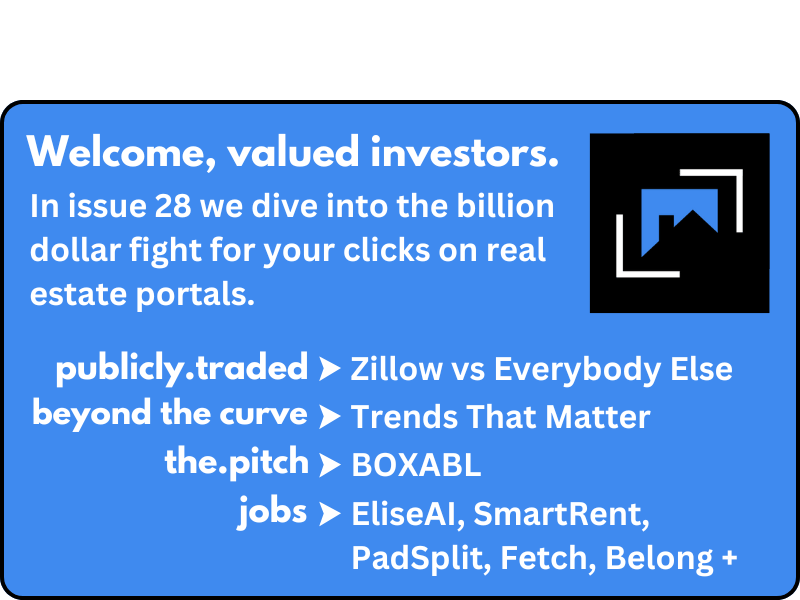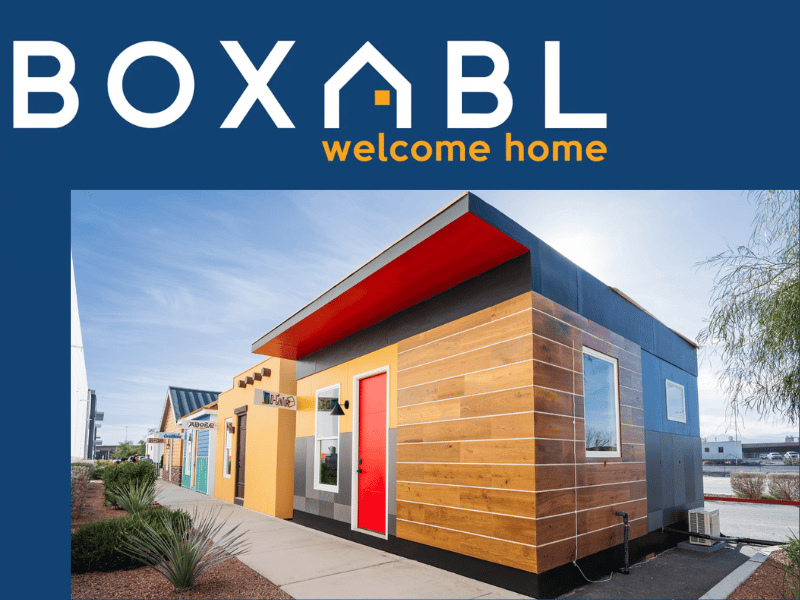



The Billion Dollar Fight in the Sandbox over Listings
The fight in the sandbox over where and how homes are listed is not about who gets to play with the biggest shovel. It’s more like a playground squabble over who charges the higher toll to play in that sandbox.
Zillow still rules the headline numbers: 227 million monthly users in Q1 2025, up 5 percent year over year, coupled with a 13 percent bump in revenue, thanks largely to mortgage pull-through that now kicks in roughly $41 million a quarter.
The math is simple: grab a buyer at the search bar, sell the lead to a Premier Agent, then package the loan, title, and closing. Each mortgage that gets funded is worth five figures in lifetime value, so early-funnel control equals cash.
CoStar’s Homes.com family is clawing for the same prize. Traffic across Homes.com, Apartments.com, and LoopNet climbed to a combined 104 million monthly visitors, driving the company’s revenue up 12 percent, even while a $31 million write-down for the 3D digital mapping technology firm Matterport pushed the quarter into the red.
CEO Andy Florance keeps repeating that portals should be “partners, not predators,” but the spreadsheet shows he wants the same downstream fees, just with softer lighting and a smiley emoji.
Enter the rulebook rewrite. The National Association of Realtors’ clear-cooperation settlement loosened the one-day must-hit-the-MLS mandate, and Compass took maybe five minutes to weaponize the gap. Its “Private Exclusives” program now boasts what the brokerage claims is the largest off-MLS inventory in the country, catnip for sellers who crave discretion and buyers who crave scarcity. With big-brand copycats lining up, the MLS no longer looks like a mandatory on-ramp; it is becoming an optional detour.
Zillow’s response: drop the velvet rope. Starting June 30, any listing splashed on a brokerage site or Instagram but missing from the MLS within 24 hours gets booted from Zillow. Agents began receiving friendly “fix it” emails on May 28; strike three and the listing disappears.
Publicly the company says it is defending transparency; privately it is guarding the Premier-Agent auction that props up the stock price. If exclusive inventory leaks elsewhere, those juicy lead bids dry up, and so does the mortgage pipeline.
CoStar smelled blood. Homes.com vowed to boost every off-MLS listing Zillow blocks and plastered billboards with “Your listing, your lead. Unlike other websites, we never sell or share your leads.” Zillow tattled to the Better Business Bureau faster than a kid telling the teacher who stole his snack. The BBB told CoStar to tone down the comparison wording, but the core promise stayed intact.
The message: list with us, keep your own inquiries, and pay a flat ad fee instead of coughing up for recycled prospects. It is less “we are saints” than “our tollbooth sits around the corner.”
Meanwhile Florance keeps lobbing grenades, calling Zillow’s MLS stance a “power play.” Homes.com has publicly pledged to host any black-listed properties for free, positioning itself as the champion of broker choice and seller autonomy. Whether altruism or marketing, the move means Homes.com owns the inventory Zillow refuses, along with the eyeballs that follow.
Investor impact
The process to efficiently source deals is becoming more challenging as the incumbent listing service providers face ongoing challenges. It’s a push against monopolistic behavior that will be equal parts good and bad for the marketplace short term. Will more mispricings exist for opportunistic investors? Sure. Will more sellers opt to list directly in a bid to reduce sales costs in spite of downstream headaches they’re not qualified to handle? Of course.
However, with change comes innovation and the real estate marketplaces of the future will be more curated, more specific, and easier to navigate. The one thing that remains the same regardless of how this plays out; those with cash and a patient eye will remain the winners amongst their peers investing in real estate.

Any Season is a Good Season to Buy
The spring buying season has always seemed to be an odd notion to us here at proptext.co, but who are we to mess with tradition. (We are people who think nothing of trudging through snow in the dark for a Monday night open house in February, but that’s us.)
This feels a bit like a chicken-and-egg scenario, as one of the reasons cited for the uptick in sales during the spring is that more homes are on the market, so more buyers are shopping. The weather is nicer too, so curb appeal is enhanced, and moving during the summer fits the school schedule. (Though there is a lot to be said for getting the kids into classes right away so they can meet their peers, rather than having them hang around the new house all summer to drive their parents bananas.)
There are plenty of arguments against joining the spring home buying frenzy, though this spring buying season is shaping up to be a bit of a dud. As noted in a recent article on Yahoo!/Finance, competition for properties is keenest in spring and summer, which can push up prices too. The better deals for homes can be found in fall and especially winter.
Realtor.com pinpointed the best week in 2025 for those hoping to sell during the spring buying season, a claim that we find a bit dubious: “The week of April 13-19 is expected to have the ideal balance of housing market conditions that favor home sellers.”
Those who buy this advice need to wait until next year. Our advice: sell when you are ready to sell.
Of Interest
The Wall Street Journal reported (paywalled) that the spring home sales season is off to a slow start. There is more inventory, but with home prices and mortgage rates persistently high, buyers seem discouraged during what is usually the busiest buying season.
Builder magazine released its annual list of the top 200 home builders in the US, ranked by closings. A lot of familiar names here, but what stands out to us is how much the top two, D.R. Horton (93,311 closings) and Lennar Corp. (80,210), dominate the industry. The combined 173,521 closing are greater than the next 12 home builders combined.
The slowdown in the spring sales season is impacting home builders as well, said Jody Kahn, Senior VP of Research Surveys at The Builder’s Daily, and companies are recalibrating the plans they made at the start of the year, reducing starts, reevaluating pricing, trimming headcount in some regions, and rethinking land positions.
USA Today posed the question we haven’t heard in a while: Is it finally a buyer’s market? Prices rose about 50% over the last five years, which has made it difficult for buyers, especially first-timers, to get. The mortgage rate “lock-in effect,” where those holding paper with rates lower than 4 percent (vs the current 30-year rate of about 6.8%) are reluctant to sell, appears to be easing. Realtor.com data show that in April there were 959,251 active listings, 30% higher than April last year, and close to 2019 levels. While some of that was due to homes staying on the market longer, listings were up about 10% a month between February and April.
Just Because
Thea Duncan Prado spent a semester in 2003 studying in L’Aquila, Italy, which changed her life. As Prado recounted in a story published on CNBC.com, she returned two years later to study for a master’s degree in Milan, then moved there in 2012 with her Italian husband. They found a 1,227-square foot 3-bedroom, 2-bathroom apartment in Milan three years ago for about $1,850 a month. The place needed work, and since there are government incentives for renovations, even for renters, they took the plunge. The incentives paid, and 8 months of waived rent, paid for almost $33,400 of the $41,000 of the project cost. If you are thinking of chucking it all and moving to Italy, Prado has a business, Doing Italy, that can help. Aside from the amazing food and vibrant culture, there is another thing sacred to Italians: “Unlike in the U.S., people actually use their vacation time,” she wrote.

Mortgage Demand | Applications fell 4% week-over-week, reaching the lowest level since February (New York Post) | Indicates buyer hesitation due to economic concerns, despite slightly lower interest rates. |
Home Price Trends | Growth returning to long-term averages; demand remains weak amid economic uncertainty (Cotality) | Potential stabilization in prices, but ongoing caution among buyers may limit rapid appreciation. |
Housing Starts | Decreased by 11.4% in March to 1.324 million units, the lowest in four months (Trading Economics) | Significant decline suggests reduced construction activity, potentially leading to tighter housing supply. |
Building Permits | Increased by 0.5% in March to 1.467 million units (Trading Economics) | Slight uptick indicates potential future construction activity, though overall levels remain moderate. |


BOXABL
Boxabl wants to turn homebuilding into a manufacturing process that produces a house that can be shipped like a couch. Founded in 2017 by father and son Paolo and Galiano Tiramani, the Las Vegas firm folds an entire studio apartment into an eight-foot-wide road-legal box that a pickup can tow. Unfold it on-site, plug in utilities, and a 375-square-foot Casita is ready before lunch.
From Concept to Creation: Boxabl’s Journey
The idea drew attention at the CES 2020, when the prototype was popped open live on stage. A 170,000 square-foot facility, called Factory 1, went up in North Las Vegas in 2021, followed by an even larger Factory 2. The company says it can build 4,500 units per year, though real-world output is climbing slowly as the team fine-tunes assembly lines and customers wrangle zoning and utility hookups.
What Makes Boxabl Unique
Flat-pack physics. Floor, walls, roof, wiring, and insulation hinge together inside a single shippable cube.
Legoland potential. New modules in development let owners stack or attach multiple boxes, creating townhomes or small apartment blocks without custom plans.
Factory first. Roughly 80% of construction happens indoors, aiming for lower costs, tighter tolerances, and minimal site waste.
A Deeper Dive with the Team
In a recent livestream, COO Galiano Tiramani highlighted two numbers that guide daily decisions: cost per unit and cycle time. Every station on the line is benchmarked in seconds, and any part that slows the flow is redesigned or automated. He noted that early Casitas required about six labor hours on the floor; the target is two.
Key Metrics Snapshot
Reservations: 160 000+ with deposits.
Delivered: 156 Casitas handed to the U.S. military, plus 140 retail installs through 2024.
Price tag: Historically around $60,000 for a fully finished Casita (land, permits, and utilities not included).
Funding: More than $12 million raised in Regulation A crowdfunding this spring, pushing total small-investor count above 50,000.
How Can You Get Started?
First, confirm local zoning allows an accessory dwelling unit or modular build. Next, join the reservation list with a refundable $200 deposit. While you wait, line up site prep: a simple foundation, utility stubs, and a clear crane path. When your box ships, expect about an hour to unfold and one day for hookups.
The Takeaway
Boxabl is still trying to prove it can scale from clever prototype to reliable production, yet the upside is hard to ignore. If the factories hit stride, cities could drop move-in-ready homes on vacant lots, rural employers could create staff housing in a weekend, and homeowners might add instant rental income in the backyard. Keep an eye on build speeds, unit costs, and local code adoption; those three levers will decide whether fold-up housing moves from viral video to mainstream inventory.


Sales & Marketing roles:
National Account Executive, Fetch, remote
Account Executive, PadSplit, Denver, CO
Vice President, Strategic Accounts, SmartRent, remote
Product & Engineering roles:
Senior Product Manager, Crexi, Playa Vista, CA
Analytics Engineer, Funnel Leasing, remote
Staff Machine Learning Engineer, Doma, remote
Operations roles:
Product Operations Specialist, EliseAI, New York, NY
Director, Strategic Planning & Operations, Metropolis, New York, NY
Growth Lead, Belong, Miami, FL
StartEngine’s $30M Surge — Own a Piece Before June 26
Private markets are having a moment, thanks to companies like StartEngine.
The leading alternative investing platform is helping everyday investors like you access deals once reserved for VCs and insiders, including exposure to private market titans like OpenAI, Databricks, and Perplexity.¹
How’s it going? In Q1 2025, StartEngine pulled off $30M in revenue, its biggest quarter ever (based on unaudited financials).²
But StartEngine isn’t just a middleman. The company earns 20% carried interest on select pre-IPO offerings, unlocking value for shareholders when these deals succeed.³
How can you tap into this diversification play? By investing in StartEngine.
StartEngine has crowdfunded $85M+ to date, and you can join 45K+ shareholders before the company’s current round closes on June 26.
Reg A+ via StartEngine Crowdfunding, Inc. No BD/intermediary involved. Investment is speculative, illiquid & high risk. See OC and Risks on page.
Refer and Earn
You can earn free prop.text merch for referring investors to the newsletter
25 referrals - hat 🧢
50 referrals - tee shirt 👕
100 referrals - weekender bag 🎒
Copy & paste this link: {{rp_refer_url}}

